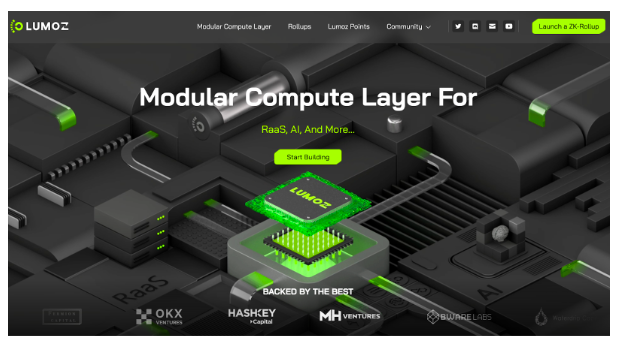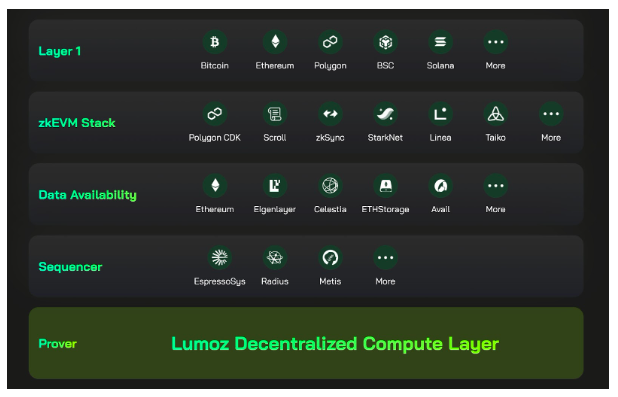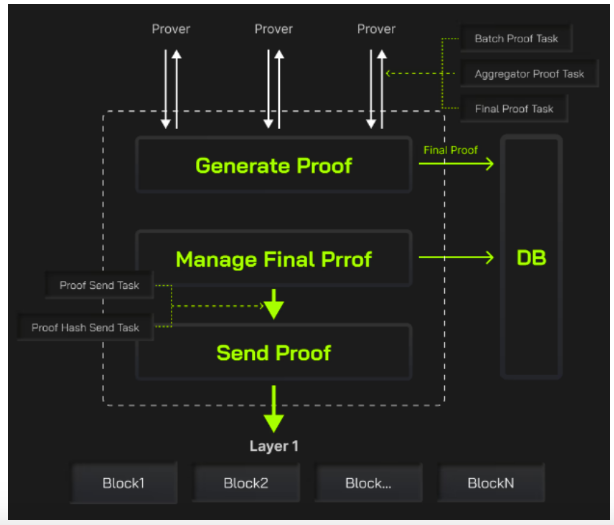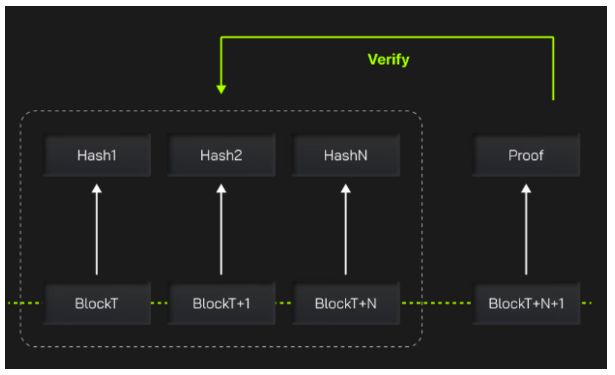Bitcoin hit a new all-time high, announcing the return of the bull market. At the same time, as the largest ecosystem, competition in the Layer 2 (L2) field of Ethereum has become more intense. Many projects are sure to seize the opportunity of this bull run to achieve higher FDV. Among them, the ZK-Rollup field shows great development potential. Why so sure? Some clues may be seen from the narrative that Lumoz is betting on ZK computing power and opening up a new modular track.

1. Why are you optimistic about modular computing power?
From a technical perspective, a Rollup is divided into at least three modules: data availability (DA), serializer (Sequencer), and prover (Prover). Among these modules, there are already projects in the DA and Sequencer fields that have achieved remarkable results, such as Celestia and EigenDA, which have a market value of tens of billions, and have set examples for the modular development of blockchain. However, in the ZK-Rollup field, the cost of Prover modules is even higher than that of DA, and no strong competitor has emerged yet. Lumoz is currently the only computing power provider in this field.

On the other hand, with the implementation of Ethereum Cancun upgrade EIP-4844, support for Rollups has increased, and more projects will emerge in the future. At the same time, after the transition from Ethereum’s PoW to PoS, many Ethereum mining equipment lost their usefulness. According to statistics, approximately US$12 billion worth of mining equipment is currently idle, and it is necessary to re-find scenarios for value realization. In this context, with the large-scale implementation of ZK-Rollup, generating ZKP requires a large amount of hardware resources and mining equipment, and providing modular computing power will naturally become the next broad blue ocean market.
2. Dismantling Lumoz’s hard power in modular computing power
Lumoz is a decentralized ZK-RaaS (ZK-Rollup as a service) platform and a PoW (Proof of Work) network that supports ZKP (Zero Knowledge Proof) mining. It can be seen from its platform positioning that RaaS and computing power are naturally mutually reinforcing and interdependent, and are the cornerstone of the sustainable development and innovation of cloud capabilities.
Next, we will delve into Lumoz’s hard power in modular computing power and break down its specific content in three major aspects: technological innovation, reward mechanism and its own advantages. Through the analysis of Lumoz, we can better understand the core advantages and innovations of modular computing power technology in Lumoz.
1. Technological innovation: optimized ZKP generation algorithm
In some open source zkEVMs, ZKP calculation and submission are performed sequentially. This can become a bottleneck when ZK-Rollup submits a large number of sequences because miners cannot compute multiple ZKPs in parallel. Lumozs two-step submission algorithm implements parallel calculation and sequential submission of ZKP, enabling miners to perform multiple ZKP generation tasks at the same time, significantly improving ZKP generation efficiency.
In addition, the Lumoz team also improved the ZKP recursive aggregation algorithm, significantly improving the utilization of machine resources in the cluster and further speeding up ZKP calculations. Stress testing in a real-world environment showed that a rate of 27.8 transactions per second could be sustained in about 40 minutes using a cluster of 20 machines, each with 128 cores CPU and 1 TB of memory. Under similar conditions, Lumoz successfully reduced the average transaction confirmation time from approximately 5-6 minutes to approximately 3 minutes, increasing ZKP generation efficiency by approximately 80%.

ZKP recursive aggregation algorithm mechanism
Among them, Aggregator is an important component module of Prover. It is responsible for the three sub-modules of sending and receiving, submitting and managing ZKP certification tasks:
Proof Generator, responsible for task distribution:Assign the proof task to the Prover (PoW miner), receive the task result (ZKP generated by the miner) and store the ZKP proof in the DB database. Its characteristic is that it can be generated in parallel, that is, different proof generation sequences can be completed at the same time (there is no contextual relationship), and multiple BatchProofTasks can be executed simultaneously within the same sequence.
Proof Manager is responsible for managing completed ZKP:Responsible for managing ZKP certificates and controlling their on-chain verification, ensuring that all ZKP certificates can be verified on-chain in a timely manner.
Proof Sender is responsible for submitting ZKP to zkvm:Submit the ZKP proof to the zkevm contract deployed on the base chain.

High performance prover component
2. Reward mechanism optimization: two-step submission mechanism for ZKP verification
Miners are Proof Sender. In order to encourage more miners to participate in ZKP computing tasks at the same time, Lumoz proposed a two-step submission mechanism for ZKP verification, which allocates the ZKP PoW reward share to valid ZKP submitters according to certain rules.

Two-step submission mechanism
1) Submit the hash
For a certain sequence, after the prover calculates the ZKP, it calculates the proof hash and submits it to the contract.
Assuming the first prover submits a hash in block T, other provers can submit hashes until block T+10 without limit. In block T+ 11 and later, new provers will not be accepted to submit hashes.
2) Submit ZKP
After block T+11, any prover can submit ZKP. Any prover that passes verification will receive a PoW reward, which is distributed in proportion to the miners stake amount.
If no ZKP is verified before block T+42, the prover who previously submitted the hash will forfeit 1,000 MOZ and the sequence will be reopened, allowing new hashes to be submitted.
For example, assuming that the PoW reward for each L2 block in the Lumoz chain is 128 MOZ, and there are 64 Rollup slots in total, the PoW reward allocated to each Rollup sequence is 2 MOZ. Then the PoW rewards of A, B and C are 0.4 MOZ, 1 MOZ and 0.6 MOZ respectively.
according toofficial dataStatistics show that Version 2.0 uses 10 64-core machines to complete 566 batch proofs. It takes 7 hours, 38 minutes and 40 seconds to complete one proof in an average of 48.62 seconds. In a multi-miner scenario, compared to V1.0, the overall zk proof generation efficiency of V2.0 has increased by 50%.
3. Own advantages: ZK-Rollup practical experience + mining pool resources
For the modular computing power track, this requires not only practical experience in the ZK-Rollup field, but also PoW mining resources. The Lumoz team has both in their DNA.
In 2021, Lumoz started the ZK project. In May 2023, Lumoz officially launched the test network and has been running smoothly to this day. More than 15 projects have passed official review and generated customized zkEVM applications on the Lumoz platform. chain. The two recently popular chains, ETH L2 ZKFair BTC L2 Merlin, are also technically supported by Lumoz. Currently, ZKFair has been launched on the main network and has gained support from community users with the help of the Fair Launch model. Merlin Chain’s current market The popularity is self-evident. The blessing of two star products has also attracted attention to Lumoz.
Of course, in terms of mining, Lumoz also has close relationships with two well-known mining pool brands, 6 Block and ZK.Work. Previously, the two have been providing stable mining services to miners with their wide influence and good reputation, and have performed well in terms of technology, security and efficiency.
These advantages have laid the foundation for Lumoz. Therefore, for Lumoz, developing modular computing power is more like a natural extension and evolution, allowing it to occupy a favorable position in the modular computing power layer track.
3. Test network data strength: large number of participants and considerable ZKP output
Lumoz’s first two phases of testnet data demonstrate its strength and promising development trend in the field of modular computing power. Judging from the number of miners and validators, PoW miners have reached 145, and PoS validators have reached 28,000, making it one of the largest test networks. This not only shows Lumoz’s success in attracting miners and validators, but also proves the industry’s trust and expectation in it.
Further analysis of the data from the first two phases of the test network shows that nearly 5 million ZKPs have been generated in just a few months. The number of these ZKPs is enough to support hundreds of ZK L2 operations for a whole year, which shows its future development. potential.
In addition, it can also be seen from the income of miners and validators that their income is in line with expectations, which further strengthens participants confidence and investment in the Lumoz project. The hardware cost of PoW miners is estimated to be over $30 million, highlighting the importance and investment miners place on the Lumoz platform. The number and income of validators also reflect their recognition of Lumoz technology and development prospects.
4. Summary
Just on April 8, Lumoz disclosed that it had completed a new round of financing at a valuation of US$120 million, with participation from OKX Ventures, HashKey Capital, KuCoin Ventures, Comma 3 Ventures, Kronos Ventures, Kernel Ventures and Polygon co-founder Sandeep Nailwal . So far, the amount raised is up to $10 million.
Of course, for a project with development potential, financing is just the beginning. The real key lies in how to effectively manage and utilize these resources to achieve long-term sustainable development and success. Judging from the FDV of more mature projects such as Celesitia, EigenDA, and Availe, the value can reach tens of billions of dollars. As the first crab-eating project on the Prover track, Lumoz is expected to achieve the same amazing valuation, demonstrating its huge potential. Growth potential. Not only that, in addition to serving ZK-Rollup, Lumoz’s computing power can also be provided for more scenarios such as AI and DePIN, which naturally opens up more room for imagination.
In terms of capabilities, as ZK-RaaS, Lumoz currently officially announces that it has cooperated with 40+ project parties, integrated 20+ projects, and supports the one-click generation of Polygon CDK, zkSync, Scroll, StarkNet and other types of ZK-Rollup in ten minutes. Has become Polygons officially certified CDK technical service provider. As a ZK-PoW cloud, Lumoz combines mining pool resources + ZK-PoW strength. Its hard-to-replicate soft and hard strength, combined with the ZK DePIN concept, will have greater potential for future development.
Taken together, Lumoz’s first-mover advantage in the Prover field, rich cooperation experience, diversified technical support and innovative ideas will lay a solid foundation for its future development. In the field of ZK-Rollup, Lumoz will also play an important role to achieve greater business value and technical influence.
Also, get involved nowDragon SlayerYou can get Lumoz points. Dragon Slayer is the first large-scale gamified ecological event jointly launched by ZKFair and Lumoz. The event has designed a series of challenging levels and adventure elements. You can not only experience the fun of the game, but also win Lumoz points and USDC rewards. . The total prize pool offers over 30 million Lumoz Points and 50,000 USDC rewards spread across three ever-escalating levels. The event has now entered its final chapter, with nearly 150,000 users participating, and the registration channel is still open. In the future, Lumoz points will be redeemable for Lumoz tokens.



